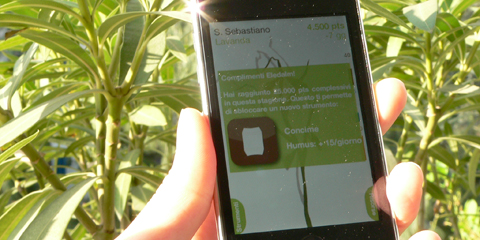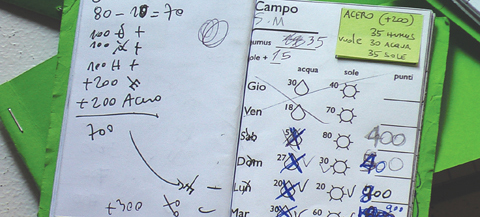BACKGROUND
Location-based games are new forms of play that take place in real space and are played with digital mobile technologies. They usually need location-awareness or positioning technologies and an Internet connection. This graduate thesis aims to create a new ludic experience by mixing virtual with real-world elements. It is a casual game: collaborative (promoting social interaction, organization, teamwork and strategy), creative (not top-down: players could produce part of the game), contagious and concrete (dealing with real-world issues and trying to infect physical spaces with the imaginary power of virtuality).
CONCEPT
Greengrowers is a location-based game for the Apple iPhone. Using GPS technology, players plant virtual seeds in the squares of Venice; the aim is to grow virtual plants and make them bloom, over a 14-day period, before other players do. Players can use humus (site-specific), water and sun (from real weather data), and an increasing set of tools. Seasonal climate also affects game elements and their attributes. After each period winners receive real seeds that local institutions will plant in the players’ favourite square.
From the very beginning I thought the game should have a very delicate and abstract aspect. The works of Bruno Munari (an Italian designer who contributed greatly to basic design, games and creativity) have strongly inspired me. I decided to work with paper and exploit its physical qualities. The plants in the game are bits of coloured paper animated with video editing techniques: an attempt to mix tradition with digital technologies.
Scenarios of the main game phases
Game design is an iterative process. After an early focus group with possible users, I quickly turned to prototyping. However, the development of a shiny, polished and fully working prototype is just the last step of a series of trials. The evaluation of a location-based game, in particular, needs many iterations. So I started to refine my design using low-fi prototypes. I made small paper booklets with a simplified version of the main rules I had designed; I attached lists of seeds, half a dozen places where to play, and their characteristics; finally I asked testers to fill in data and to proceed with their strategy, always in one of the given Venetian squares. The results, analyzed and evaluated with the aid of a semi-structured questionnaire, defined the major revisions needed. Most gratifying was the enjoyment expressed by the participants, even with such a “quick and dirty” mock-up.
NEXT STEPS
Greengrowers could be the starting point for a larger platform which might involve other cities and, through collaboration with local authorities, aim to sustain environmental issues in specific areas.
ACKNOWLEDGMENTS
I would like to thank the Area/code people in New York: Kevin Cancienne, Christian Croft, Mark Heggen, Frank Lantz, Kati London, Jacky Tran and Kevin Slavin for the great opportunity they gave me. Many thanks to Tomas Barazza and Marco Zamarato at Log607 in Treviso for their precious insights on my early thoughts. Thanks too to Venice Local Council Green Areas Unit and to all IUAV IxD students and friends who took part in the initial focus group and the first prototype evaluation.
Download here my thesis report in Italian [PDF | 4.2 MB, screen quality]

